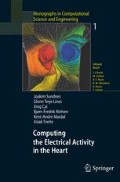Abstract
Our knowledge about the heart dates back more than two millenia. Already in the days of Aristotle (350 b.c.) the importance of the heart was recognized, and it was, in fact, considered to be the most important organ in the body. Other vital organs, such as the brain and lungs, were thought to exist merely to cool the blood. Over two thousand years later, the heart maintains its position as one of the most important, and also most studied, organs in the human body.
Access this chapter
Tax calculation will be finalised at checkout
Purchases are for personal use only
Preview
Unable to display preview. Download preview PDF.
Author information
Authors and Affiliations
Rights and permissions
Copyright information
© 2006 Springer
About this chapter
Cite this chapter
Sundnes, J., Lines, G.T., Cai, X., Nielsen, B.F., Mardal, KA., Tveito, A. (2006). Physiological Background. In: Computing the Electrical Activity in the Heart. Monographs in Computational Science and Engineering, vol 1. Springer, Berlin, Heidelberg. https://doi.org/10.1007/3-540-33437-8_1
Download citation
DOI: https://doi.org/10.1007/3-540-33437-8_1
Publisher Name: Springer, Berlin, Heidelberg
Print ISBN: 978-3-540-33432-3
Online ISBN: 978-3-540-33437-8
eBook Packages: Mathematics and StatisticsMathematics and Statistics (R0)

